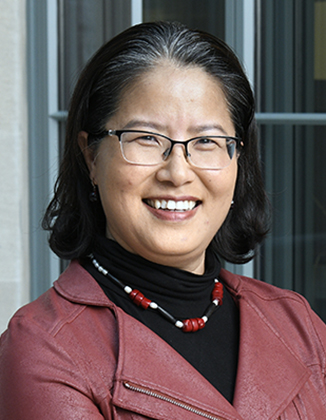Songi Han
Professor
Dr.rer.nat.: RWTH Aachen University

- songi.han@northwestern.edu
- Website
- 847-491-5060
- Silverman Hall 4611, enter through 4609
- Program Assistant: Anne Muller
Affiliations
Mark and Nancy Ratner Professor of Chemistry
Chemistry of Life Processes Institute (CLP)
International Institute of Nanotechnology (IIN)
Paula M. Trienens Institute for Sustainability and Energy
International Electron Paramagnetic Resonance Society (IES)
Research Statement
The Han lab is developing novel approaches to achieve magnetic resonance sensing of molecular interactions, molecular dynamics, and structures on wet, dynamic, and active interfaces using quantum control over electron and nuclear spin polarization and polarization transfer to achieve controlled hyperpolarization.
Professor Songi Han is a physical chemist and a magnetic resonance spectroscopist with a dedicated focus on developing out of the box experimental approaches to “visualize” molecules in action that are conventionally hard to detect but are critical to understand. Critical, but hard to see, phenomena include the structure of water that play a role in tuning the surface activity and molecular assembly, the transformation of biomolecules during folding and assembly processes, and the shape-controlled aggregation of the protein tau to fibril phenotypes that are diagnostic of specific neurodegenerative diseases known as tauopathies. Achieving any of these goals has the potential to be transformative for engineering active surfaces with desirable thermodynamic and kinetic properties, and for developing therapeutic molecules and diagnosis tools for neurodegenerative diseases.
Given the fundamental nature of these questions and the transformative prospects of achieving these goals, why has it not been accomplished already? The reason for this is a common challenge in the chemical sciences: the tools to detect molecular interactions, structure, and dynamics are “not good enough”, “not sharp enough” or “not sensitive enough” to date. Hence, new technological advances are needed that not only improve our measurements but also explore entirely new frontiers in chemical sensing.
Nuclear magnetic resonance (NMR) is a powerful tool that can detect molecular structure, dynamics, and interactions in solution state, near surfaces and in amorphous material or hybrid soft matter. NMR is sensitive to dipolar and scalar coupling between nuclear spins, and hence offers distance and coordination information, while NMR chemical shifts reports on the local electron density of the NMR-active atom. Combined with electron paramagnetic resonance (EPR) of radical and transition metals, we have an extremely rich characterization platform at hand. However, NMR suffers from intrinsically low sensitivity, rendering many exciting experimental possibilities practically infeasible. The Han lab has been pushing the frontier of dynamic nuclear polarization (DNP) to amplify NMR signal by polarization transfer from electron to nuclear spins exploiting new DNP mechanisms. Her lab is designing electron spin coupling networks with the desired energy matching and a carefully tuned distance to the closest nuclear spin to tune the coupling to the bulk nuclear spin bath, and so control the spatial propagation of nuclear spin polarization. At < 4 Kelvin and 7 Tesla, the electron spins reach near unity polarization, so that an efficient DNP transfer can in principle generate near unity nuclear spin polarization, bringing us closer to the optical limit in terms of signal intensity.
The Han lab is developing innovative spin-based tools to detect hitherto “invisible” or “faintly visible” molecular interactions, assembly, and dynamics in water-based environments, and applying these tools to solve urgent problems in biology, such as the shape-controlled protein assembly along rationalizable pathways or the design and engineering of activity on de novo proteins, pharmaceutical compounds to soft materials. The Han lab’s research focus can be divided into three areas:
(1) Quantum resonance sensing using designed e-n spin clusters
(2) Shape-controlled protein assembly and dynamic structural biology
(3) Design of active surfaces by tuning the hydration water structure
Selected Publications
For a list of publications, please visit https://hanlab.northwestern.edu/publication/
Selected Honors/Awards
2024 Bruker Prize Lecture of the Royal Society Chemistry EPR
2023 Callaghan Lecturer Prize of the ISMAR
2021 EAS Award for Outstanding Achievements in Magnetic Resonance
2020 The Mary and Joseph A. Pignolio, St. Award of University of Pennsylvania School of Medicine
2019 Biophysical Society Innovation Award
2018 Elected Fellow of the International Society for Magnetic Resonance
2015 Regitze Vold Memorial Prize Lecturer, UC San Diego (Oct 22, 2015)
2015 Bessel Humboldt Prize of the Alexander von Humboldt Foundation
2011 NIH Innovator Award
2010 Dreyfus Teacher Scholar Award
2008 Packard Fellowship for Science and Engineering
2006 NSF Faculty Early Career Development (CAREER) Award
2002 - 2004 Feodor-Lynen Fellowship of the Alexander von Humboldt Foundation
2002 Borchers Plakette for outstanding dissertation from the Aachen University of Technology
2001 Ernst Award of the GDCH (German Chemical Society) for best publication
2002 1st Raymond Andrew Prize for outstanding thesis by the Ampere Society (Europe-wide)
